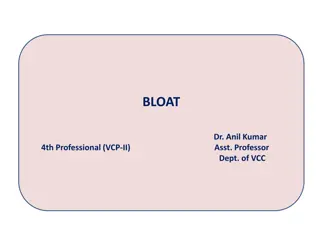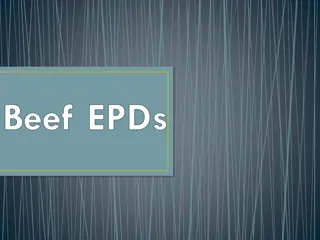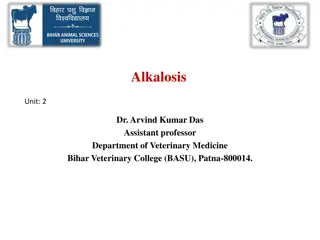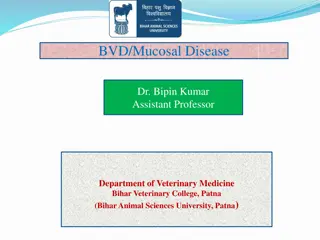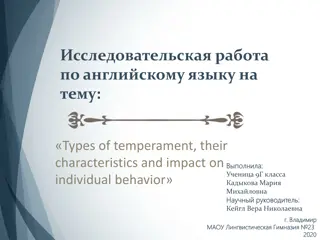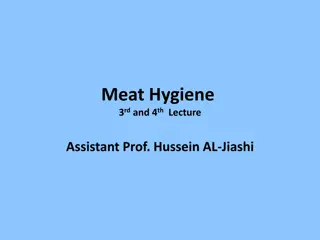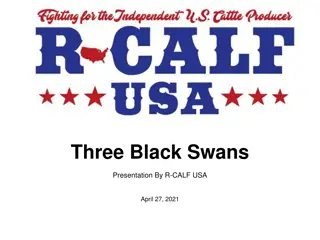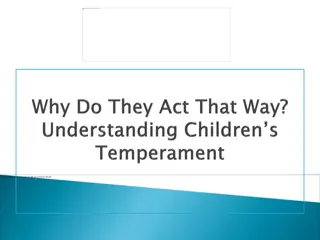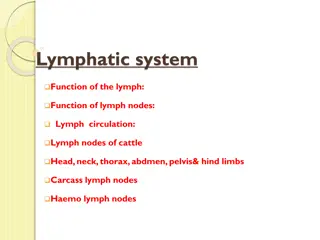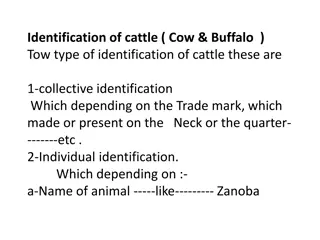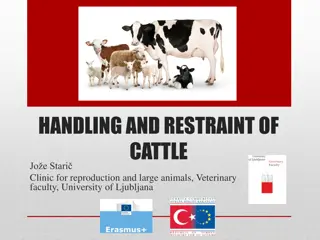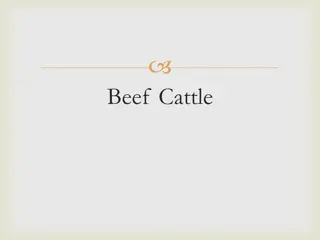Understanding Cattle Temperament: Implications for Producers
Cattle temperament plays a crucial role in the overall well-being of livestock and can impact factors such as stress levels, growth rates, and immune function. This article delves into the importance of evaluating and managing temperament in cattle to mitigate risks of injury, reduce stress-related issues, and enhance production outcomes.
Download Presentation

Please find below an Image/Link to download the presentation.
The content on the website is provided AS IS for your information and personal use only. It may not be sold, licensed, or shared on other websites without obtaining consent from the author. Download presentation by click this link. If you encounter any issues during the download, it is possible that the publisher has removed the file from their server.
E N D
Presentation Transcript
SELECTION TOOLS FOR TEMPERAMENT R. D. Randel1, R. C. Vann2and T. H. Welsh, Jr.3 1Texas AgriLife Research, Overton, TX; 2Mississippi Agricultural and Forestry Experiment Station- Brown Loam Experiment Station, Raymond, MS; 3Texas AgriLife Research, College Station, TX
THE REACTIVITY OR FEAR RESPONSE TO HUMANS (Fordyce et al., 1988)
TEMPERAMENTAL CATTLE ARE MORE EASILY STRESSED THAN THEIR CALMER HERD MATES (Curley et al., 2006, 2008)
Why Is Temperament Important To Cattle Producers? 1. Risk of injury to handlers and cattle. 2. Reduced growth rates, carcass traits and immune function.
Temperamental Cattle Have Reduced: 1. Feed Intake 2. Average Daily Gain 3. Intramuscular Fat 4. Carcass Quality 5. Response to Vaccination
Temperamental Cattle Have Increased: 1. Shear Force (tougher meat) 2. Bruised Trim 3. Dark Cutters
How Can Cattle Be Evaluated For Temperament? Table 1. BIF Guidelines Docility Score (Chute Score) Docile. Mild disposition. Gentle and easily handled. Stands and moves slowly during processing. Undisturbed, settled, somewhat dull. Does not pull on headgate when in chute. Exits chute calmly. Score 1 Restless. Quieter than average, but may be stubborn during processing. May try to back out of chute or pull back on headgate. Some flicking of tail. Exits chute promptly. Score 2 Nervous. Typical temperament is manageable, but nervous and impatient. A moderate among of struggling, movement and tail flicking. Repeated pushing and pulling headgate. Exits chute briskly. Score 3 Score 4 Flighty (Wild). Jumpy and out of control, quivers and struggles violently. May bellow and froth at the mouth. Frantically runs fence line and may jump when penned individually. Exhibits long flight distance and exits chute wildly. Score 5 Aggressive. May be similar to Score 4, but with added aggressive behavior, fearfulness, extreme agitation, and continuous movement which may include jumping and bellowing while in chute. Exits chute frantically and may exhibit attack behavior when handled alone. Very Aggressive. Extremely aggressive temperament. Thrashes about or attacks wildly when confined in small, tight places. Pronounced attack behavior. Score 6
The docility score (chute score) is recommended to be used at or near weaning. The head should be caught but without the squeeze applied.
Advantages of the Docility Score (Chute Score): 1. Easy to use during routine handling. 2. Positively correlated with other measures of temperament (r 0.35, P < 0.005).
Disadvantages of the Docility Score (Chute Score): 1. Not correlated (r = 0.09, P = 0.46) with cortisol concentrations in the blood.
BIF Guidelines Pen Score 1 = Non-aggressive (docile) Walks slowly, can be approached closely by humans, not excited by humans or facilities 2 = Slightly Aggressive Runs along fences, will stand in corner if humans stay away, may pace fence 3 = Moderately Aggressive Runs along fences, head up and will run if humans move closer, stops before hitting gates and fences, avoids humans 4 = Aggressive Runs, stays in back group, head high and very aware of humans, may run into fences and gates even with some distance, will likely run into fences if alone in pen 5 = Very Aggressive Excited, runs into fences, runs over humans and anything else in path, crazy
The pen score should be evaluated at or near weaning. A small group of calves (n = 5) are penned in a small lot (approximately 24 x 24 feet) and Approached by two observers for scoring.
Advantages of Pen Scoring: 1. Correlated with cortisol concentrations in the blood (r = 0.29, P < 0.05). 2. Correlated (r = 0.35, P < 0.005) with other measurements of temperament. 3. Repeated measurements are correlated (r = 0.25; P < 0.05) with each other and cortisol concentrations in the blood.
Disadvantages of Pen Scoring: 1. Requires another handling of the calves.
This method also is recommended to be used at or near weaning.
Advantages of Exit Velocity: 1. It is an objective measurement with no observer bias. 2. Exit velocity is correlated (r = 0.35; P < 0.005) with other measurements of temperament. 3. Exit velocity is correlated (r = 0.26; P < 0.005) with concentrations of cortisol in the blood.
Disadvantages of Exit Velocity: 1. Requires equipment for measurements. 2. Does not measure all aspects of temperament such as aggression. 3. The principal behavior measured is likely fear and dislike of being restrained alone.
Other Factors of Exit Velocity 1. Exit velocity can be measured earlier in life (3 weeks of age). 2. Temperamental calves exit velocity increases with age of the calves at a faster rate (0.011 0.0009 feet/second daily; P < 0.001) compared with calmer calves. 3. With exit velocity temperamental calves can be identified before weaning.
McGregor Genomics Project Temperament Scoring Aggressiveness willingness to hit evaluators Nervousness animals pacing, running, shaking, vocalizing Flightiness attempt to escape from handlers Gregariousness desire to return to the herd Overall Disposition (scored as a separate trait and not an average of component traits) 1 = nonaggressive 9 = extremely aggressive 1 = completely calm 9 = extremely nervous 1 = totally quiet 9 = extreme flight 9 = extreme desire to return to the herd 1 = totally willing to be separate 1 = completely docile 9 = crazy
The McGregor Genomics Project temperament scoring system requires 4 evaluators to assign scores postweaning. Two evaluators are located at each end of an alley approximately 12 x 75 feet long. Two calves are evaluated at a time in the alley.
Advantages of the McGregor Genomics Project System: 1. Evaluates multiple aspects of behavior. 2. Increased precision of measurement with the 1 to 9 scale.
Disadvantages of the McGregor Genomics Project System: 1. Requires 4 qualified observers. 2. Requires another handling of the calves.
WHAT IS BEING USED BY BREED ASSOCIATIONS?
Docility or Temperament Scores Breed System Range Age Angus BIF Docility 1 6 yearling Brangus BIF Docility 1 6 weaning and yearling Simmental BIF Docility 1 6 weaning and yearling Limousin BIF Docility 1 6 weaning and yearling Brahman Pen Score 1 5 weaning Saler Docility Score 1 5 weaning and yearling
COMMERCIAL COMPANIES ARE PROVIDING GENETIC MARKES FOR TEMPERAMENT IN CONJUNCTION WITH OTHER MARKERS
TEMPERAMENT IS A HERITABLE TRAIT
HERITABLILITY ESTIMATES RANGE FROM 0.25 TO 0.48 FOR BEEF CATTLE
BIF GUIDELINES STATE THAT TEMPERAMENT IS A MODERATELY HERITABLE TRAIT
ELIMINATION OF THE MOST TEMPERAMENTAL CATTLE FROM A BREEDING HERD WILL IMPROVE PERFORMANCE OF A HERD
ELIMINATION OF THE MOST TEMPERAMENTAL CATTLE FROM A BREED WILL IMPROVE PERFORMANCE OF A BREED








